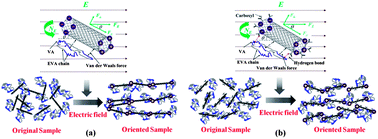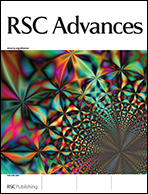Influence of surface polarity of carbon nanotubes on electric field induced aligned conductive network formation in a polymer melt†
Abstract
Pristine carbon nanotubes (CNTs) and carboxyl carbon nanotubes (CNTs-COOH) were used to study the influence of CNT surface polarity on the electric field induced aligned conductive network formation in an ethylene-vinyl acetate (EVA) melt. The dynamic rheological measurements indicated that the molecular chain–nanotube interaction in CNT-COOH–EVA was stronger than that in CNT–EVA, because of the high affinity between carboxyl groups of CNTs-COOH and ester groups of EVA chains. The critical time for the CNT or CNT-COOH conductive network formation decreased with the elevated annealing temperature and CNT loadings, but the existence of surface polarity of CNTs-COOH lowered the efficiency of conductive network formation. This was well verified by the activation energy of conductive network formation, which was ∼79.4 kJ mol−1 for CNT–EVA, obviously less than that (∼92.7 kJ mol−1) for CNT-COOH–EVA. On the basis of the thermodynamic percolation model, the percolation threshold at the equilibrium state was about 0.25 vol% for CNT–EVA, while it rose to 0.38 vol% for CNT-COOH–EVA. Moreover, morphological observations showed that the CNTs exhibited a higher degree of alignment in CNT–EVA than that in CNT-COOH–EVA induced by an electric field. These results demonstrated that the aligned nanotube conductive network tended to build up easily in a polymer melt with the relatively weak molecular chain–nanotube interactions under the action of an electric field.


 Please wait while we load your content...
Please wait while we load your content...